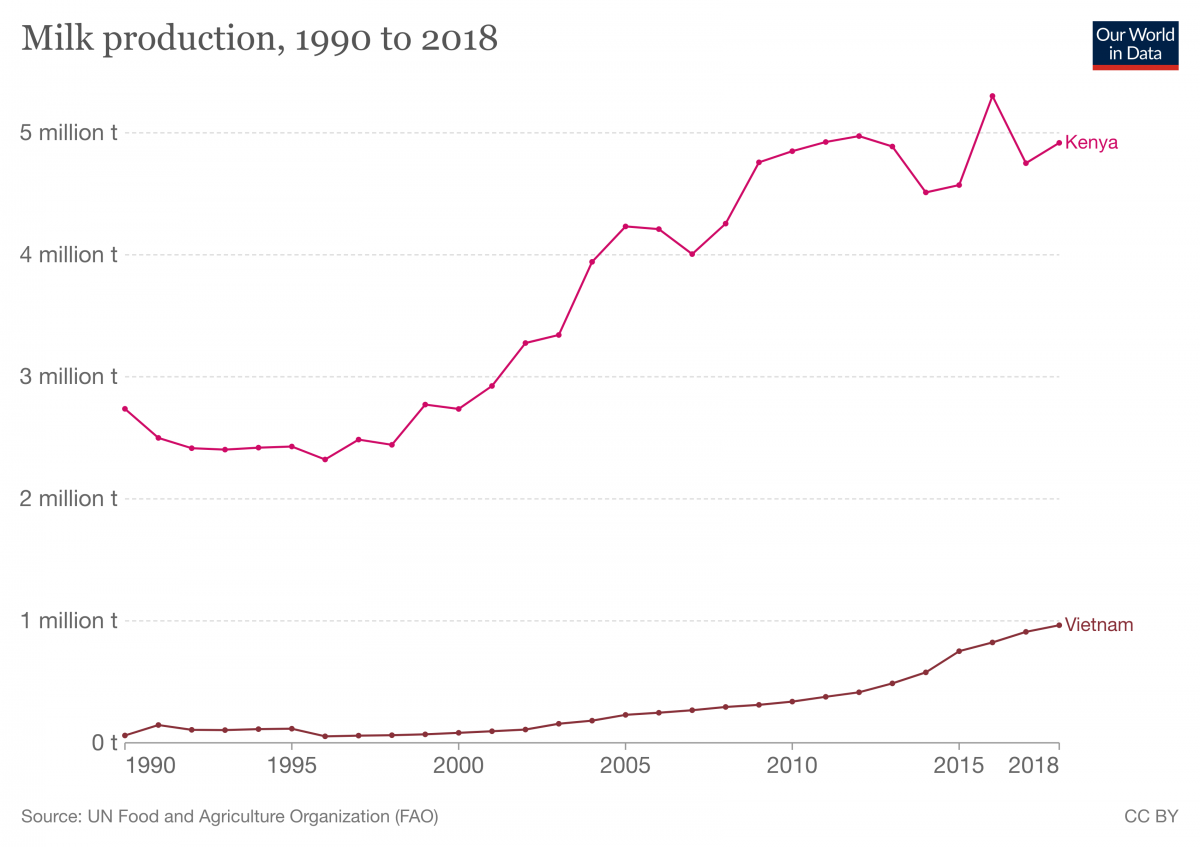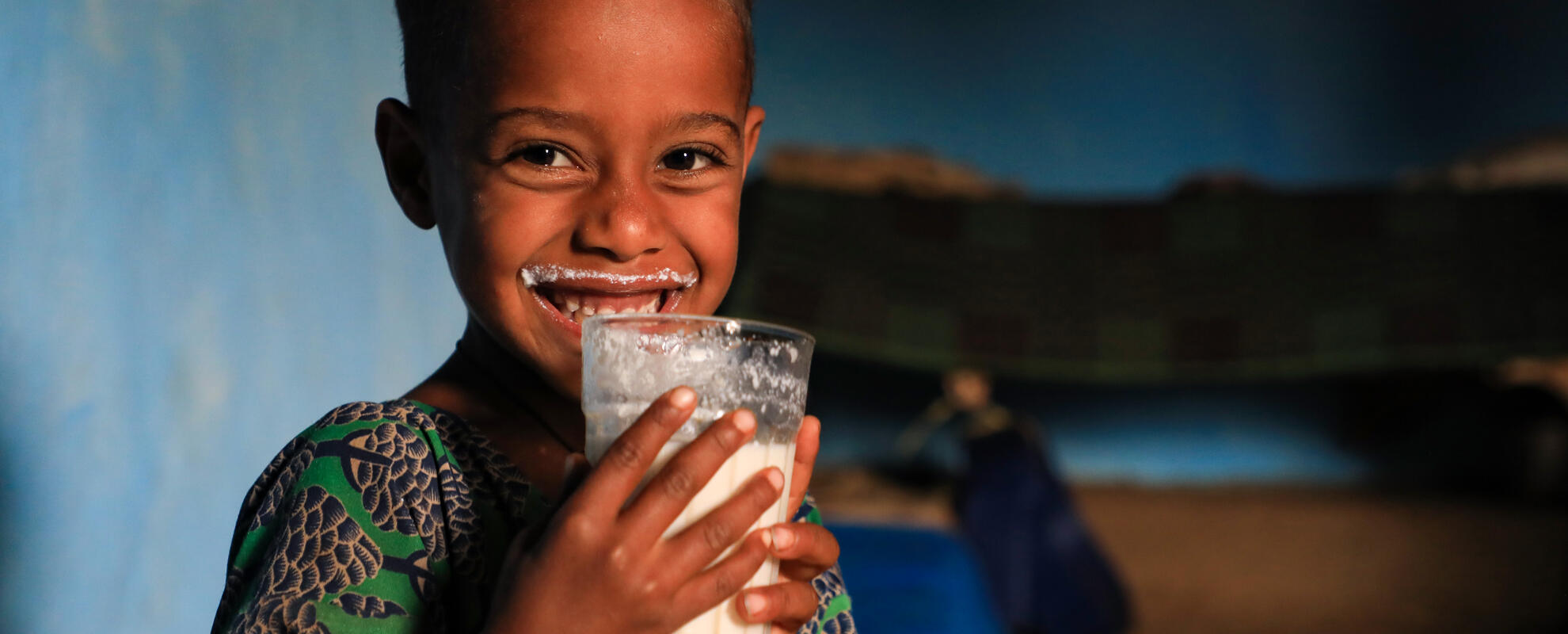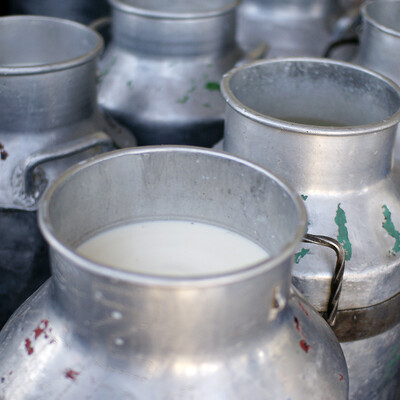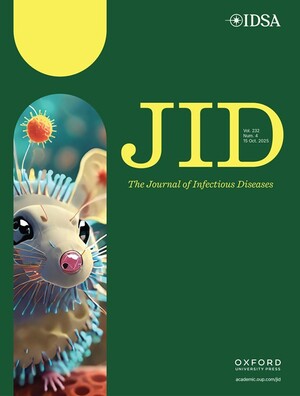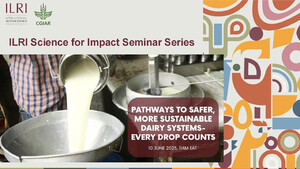
Got Milk? Lessons from Kenya and Vietnam
Globally, 663 million people are undernourished, and 22 per cent of children under the age of five are stunted, meaning their height is insufficient relative to their weight. Most of these children live in developing countries, where the most vulnerable populations cannot afford animal-sourced foods like milk. The effects are far-reaching, resulting in reduced intellectual development, diminished productivity and increased risks of chronic diseases.
Notably, between 2014 and 2018, nearly a quarter of the world's population living in low-income countries is food insecure.
According to the Food and Agriculture Organization of the United Nations (FAO), 'Milk and dairy products hold huge potential to improve nutrition and livelihoods for millions—and for children, animal milk can make the difference between accessing vital nutrients and growing healthy, or becoming stunted. A recent report by the FAO examined 13 studies investigating the relationship between dairy consumption and child growth and found a positive relationship between milk consumption, child height and weight. This tells us that animal source foods like dairy can significantly reduce child stunting and undernourishment.
The challenge is overcoming the barriers that inhibit the world's poor from accessing dairy products.
Kenya and Vietnam have both significantly increased milk consumption in the last 20 years by expanding—but in different ways. Interestingly, they both trace their modern origin story to industrial problems. In Kenya's case, it was the collapse of Kenya Cooperative Creameries (KCC), the country's main milk processing company, which held a monopoly over the processing and distribution of milk and dairy, during the 1990/92 period. In the case of Vietnam, it was the Chinese melamine crisis that spilt over to Vietnam in 2008.
Historically, milk has played a larger role in Kenya than in Vietnam. Milk consumption in East Africa can be traced 5,000 years when herders consumed it as an essential part of the diet. By contrast, there is little historical tradition for milk consumption (or production) in Vietnam, where cattle were historically used for draught power, manure and meat production.
But given the upward trajectory of their dairy industries, Kenya and Vietnam illustrate the importance of supporting smallholder farmers in increasing milk consumption. Today, most of the milk that Kenyans consume comes from a robust informal sector comprised of small-scale dairy farmers. In Vietnam, it comes from mega-farms. Yet, both countries show that by increasing production, the price of milk will fall, demand will rise, milk intake will follow, and children will grow healthier. The solutions to addressing hunger and undernourishment are not uniform.
Kenya
In Kenya, studies show that milk's nutritional value for children is widely appreciated. When it comes to infants and children under 18, approximately two-thirds of low-income consumers drink milk daily or multiple times per week. The explanation for Kenya's high milk demand is multifaceted. ILRI scientist Erastus Kang'ethe boils it down to three key considerations: a series of government policies focused on revitalising the agriculture sector, the implementation of economic recovery strategies, and widespread recognition of the importance of milk for child nutrition.
Kenyans access milk through one of two channels: The regulated formal sector, which accounts for 30 per cent of the milk market, and the informal, which accounts for 70 per cent. The industry has a longstanding history of policies rooted in colonial legislation that was originally drafted to favour the pasteurised milk sold by white settlers, but Kang'ethe also draws attention to the fact that when the dairy sector was established in the 1930s, livestock were suffering from various diseases, justifying some of the legislation. 'But those policies don't make a lot of sense now', he explains. Supporting the informal sector's smallholder farmers is crucial because by not doing so, Kenyans may no longer be able to access milk at the same low prices that the sector allows for. And that price difference is significant. Formally pasteurised milk can be 60 per cent more expensive than the milk sold through informal markets.
Policies that currently restrict the informal sector are not based on risk, which considers the likelihood of harm occurring, but on hazard, which focuses on the potential for harm—an important distinction, according to Kang'ethe. Kenyan milk culture consists of boiling the milk before consumption, and 'that’s the way people consume their milk—and they’ve been doing this forever—because they noticed that this would be a source of diseases otherwise’.
As a result, even though contracting a food-borne disease from milk has great potential to cause harm, the likelihood that someone will become sick from the milk is too low to justify doing away with the informal sector entirely.
Research also indicates that pasteurisation is not what separates safe from unsafe milk in Kenya, rather the distance and length of its trading chain and milk-handling practices. To that end, vendors are careful to inspect milk for quality before selling it to consumers, who will switch vendors if they trace any illness to their milk.
Kang’ethe recalls a study from the Smallholder Dairy Project (SDP), conducted by ILRI with Ministry of Livestock and Fisheries Department and the Kenya Agricultural Research Institute, which examined milk in totality over the course of several years, finding all milk, regardless of pasteurisation and source, to be contaminated. In short, the informal market started ‘filling a gap’ after the collapse of Kenya’s primary milk processing company between 1990 and 1992, and it was doing so without posing enough of a public risk to justify eliminating the sector. The SDP eventually became instrumental in recognizing the informal market and implementing a licensing and certification scheme that tried, but ultimately failed to chart a path towards formalization because it did not properly account for added costs to farmers who could not afford to get certified. Essentially, it was not profitable for them.
Despite the informal sectors’ criminalization, ‘the only thing that can hurt milk demand in Kenya is if prices go high,’ says Kang’ethe. Milk is culturally part of the Kenyan diet, so demand is always relatively high. What explains the 39 per cent increase in milk intake between 2003 and 2004—and the steady growth ever since—is the change in government policy. Kang’ethe notes two crucial initiatives that drew an increase in milk production: revitalizing agriculture and economic recovery.
‘With high production, you drive down the prices because the commodity is in excess and therefore more people are able to afford milk, and they can take more’, he explains.
‘If you look at our economic survey of 2005-2006, our economic growth was close to 8 to 10 per cent. It was driven by this policy that targeted productivity from the agriculture sector and with that, people started drinking more.’
Kang’ethe elaborates that whereas people might have been drinking one glass before, ‘now there’s more milk, so you’re drinking two or three glasses.’ Milk consumption in Kenya is high, says Kang'ethe, ‘not so much because we love the milk, but because we have learned through errors in the past that if we didn’t have this kind of diet, the children did not grow well, and the people were not healthy.’
Kang’ethe suggests that another way to potentially increase milk demand elsewhere—besides economic stimulation and increasing milk production—is to promote milk as part of a nutritional package to supplement diets that may not deliver full nutritional value. ‘I think if it’s sold as a component of nutrition to complement what we have, then demand would increase.’ This is also in line with a recommendation from a recent FAO report titled Dairy’s Impact on Reducing Global Hunger. According to the report, ‘dairy development needs to be accompanied by nutrition education of caregivers to ensure that milk is provided in the most critical phase of childhood.’
Vietnam
Unlike Kenya’s dominant small-scale dairy farming sector, large companies and mega-farms in Vietnam took control of the industry during the mid-to-late 2000s, replacing small family farms which accounted for over 90 per cent of milk production until 2010. With demand for milk on the rise, they—along with local governments—have been catering to increased demand while working to reduce overall reliance on imports. And while the nature of the dairy sector in Vietnam is different—with mega-farms dominating the industry—the premise behind increasing milk intake has been the same: increased market demand.
The rate of milk consumption in Vietnam is relatively low next to the global average, but demand for milk has been steadily rising throughout the last decade. Between 2019 and 2020, consumption increased by 8.6 per cent, while the dairy industry itself grew by approximately 12.7 per cent since 2010. Last year, the Southeast Asia region was responsible for an increase in United States dairy export volumes in the form of nonfat dry milk and skim milk powder. In response to the dairy industry’s growth, the Minister for Agriculture and Rural Development, Nguyen Xuan Cuong, has encouraged companies and dairy farmers to increase investments and expand production to meet domestic demand.
Vietnam’s growth in milk demand has been attributed to many reasons, including growing incomes, a growing population, and increased consumption of milk among the elderly, which is projected to double in the next seventeen years. To match this growth, Vietnam has begun intensifying the development of dairy farms, with plans to increase its dairy cattle by 200,000 by 2030. Local companies have also been working with foreign experts to match the gap in technical knowledge to increase productivity and milk quality and acquire modern equipment. However, these measures are hardly new.
After the melamine crisis of 2008, when Vietnam imported contaminated milk from China, the government began enacting policies supporting the industrialisation of the dairy sector in response to reduced consumer confidence in livestock farmers. This partially explains the beginning-of-the end of small-scale dairy farming, and the onset of large-scale industrial farms. While family dairy farms continue to exist, roughly 40 per cent of dairy farms are large-scale. This concentration of the dairy industry became a major player in increasing the demand for local milk.
According to a recent study that the International Livestock Research Institute (ILRI) participated in, greater demand for local milk as a result of the melamine crisis, government support for large business projects in the dairy industry, and the industrialisation of dairy farming ultimately led to mega-farms. More recent efforts to expand production through big companies and large-scale farming reflect these initial efforts.
Notably, growing competition in the milk market and the consolidation of the dairy industry burdened small-scale dairy farmers whose livelihoods were tied to the sector. While government support of big companies and mega-farms have charted a path toward greater production that is more suited to meet higher demand, the Vietnamese experience also shows that the costs of these benefits may fall heavily on smallholder farmers who are left unable to compete in the market.
Conclusion
Ongoing success stories like those of Kenya and Vietnam—which demonstrate different potential pathways to increase milk and dairy products consumption—showcase how the global community’s nutrition challenges are not unsolvable, but they require targeted government responses. For developing countries that struggle the most to meet adequate levels of milk consumption, expanding milk production is one way to increase its affordability and accessibility to the most economically vulnerable populations. By ensuring that milk is in excess, the price of milk and dairy products will decrease, and milk intake will rise.
Equally important is supporting smallholder dairy farmers, who, for countries like Kenya, ensure that milk remains affordable to many. From Vietnam, we also learn the importance of supporting small-scale dairy farmers through countrywide efforts to consolidate the industry.
The final lesson is to address milk-drinking habits wherever possible. In Kenya, milk is widely considered a necessary component of the average diet, especially for children. Therefore, promoting milk as a crucial aspect of child nutrition should not be underestimated.
The key takeaway is that even when countries address comparable challenges differently, some patterns and trends hint at potential pathways for the rest of the world, and like both of these countries show, increasing production, supporting smallholder farmers, and emphasising the importance of drinking milk for children, are aspects of the answer.
